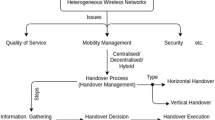Abstract
Network protocol design and evaluation requires either full implementation of the considered protocol and evaluation in a real network, or a simulation based on a model. There is also a middle approach in which both simulation and emulation are used to evaluate a protocol. In this article the Partov engine, which provides both simulation and emulation capabilities simultaneously, is presented. Partov benefits from a layered and platform-independent architecture. As a pure simulator, it provides an extensible plugin-based platform that can be configured to perform both real-time and non-real-time discrete-event simulations. It also acts as an emulator, making interaction with real networks possible in real time. Additionally, a declarative XML-based language is used, acting as a glue between simulation and emulation modules and plugins. It supports dynamic network modelling and simulation based on continuous time Markov chains. Partov is compared with other well-known tools such as NS-3 and real processes such as Hping3. It is shown that Partov requires less overhead and is much more scalable than NS-3.
Similar content being viewed by others
Notes
NS 3.19 is used in the experiments.
References
Accetta M et al (1986). Mach: A new kernel foundation for UNIX development. In: Proceedings of the Summer 1986 USENIX Conference, Atlanta, GA, pp 93–112.
Arlitt MF and Williamson CL (1996). Web server workload characterization: The search for invariants. In: Gaither BD (ed) ACM SIGMETRICS Performance Evaluation Review, Philadelphia, PA, Vol. 24, no. 1, pp 126–137.
Casado M and McKeown N (2005). The virtual network system. SIGCSE Bulletin 37(1): 76–80.
Emulab (2014). Emulab—Network Emulation Testbed Home. http://www.emulab.net/, accessed 12 February 2014.
Frazier H and Johnson H (1999). Gigabit ethernet: From 100 to 1,000 mbps. Internet Computing, IEEE 3(1): 24–31.
GNU (1999). time—GNU Project—Free Software Foundation (FSF). http://www.gnu.org/software/time/, accessed 12 February 2014.
Henderson T (2010). NS-3 tutorial. In: 9th GENI Engineering Conference (GEC9) Workshops and Tutorials, Washington DC.
Hping3 (2006). Hping security tool—Hping3 information. http://www.hping.org/hping3.html, accessed 12 February 2014.
ISO/IEC (1996). Information technology—Open systems interconnection—Basic reference model: The basic model. Number ISO/IEC 7498-1:1994(E).
Jimenez T and Ros D (eds) (2006). Proceeding from the 2006 workshop on NS-2: the IP network simulator, WNS2 ’06. ACM Press: New York, NY.
Kaparti R (2005). OPNET IT guru: A tool for networking education. Mscit practium paper, Regis University.
Libpcap (2014). TCPDUMP/LIBPCAP public repository. http://www.tcpdump.org/, accessed 12 February 2014.
Lisha G and Junzhou L (2006). Performance analysis of a p2p-based voip software. In: Telecommunications, 2006. AICT-ICIW’06. International Conference on Internet and Web Applications and Services/Advanced International Conference on, Guadelope, French Caribbean.
Momeni B and Kharrazi M (2012). Improving a computer networks course using the partov simulation engine. Education, IEEE Transactions on 55(3): 436–443.
MySQL (2014). MySQL: The world’s most popular open source database. http://www.mysql.com/, accessed 12 February 2014.
Nethi S, Pohjola M, Eriksson L and Jantti R (2007). Platform for emulating networked control systems in laboratory environments. In: World of Wireless, Mobile and Multimedia Networks, 2007. WoWMoM 2007. IEEE International Symposium on a, Espoo, Finland, pp 1–8.
NS-2 (2011). The Network Simulator—NS-2. http://www.isi.edu/nsnam/ns/, accessed 12 February 2014.
Park C, Shen H, Marron JS, Hernandez-Campos F and Veitch D (2006). Capturing the elusive poissonity in web traffic. In: Modeling, Analysis, and Simulation of Computer and Telecommunication Systems, 2006. MASCOTS 2006. 14th IEEE International Symposium on, Monterey, CA, pp 189–196.
PlanetLab (2012). PlanetLab—An open platform for developing, deploying, and accessing planetary-scale services. http://www.planet-lab.org/, accessed 12 February 2014.
Qt (2014). Qt—developer resources—documentation, guides, forums. http://www.qt.io/developers/, accessed 12 February 2014.
Reineck KM (2008). Evaluation and comparison of network simulation tools. Master’s thesis, Department of Computer Science, University of Applied Sciences, Bonn-Rhein-Sieg.
Ross SM (ed) (2010). Chapter 6 – Continuous-time markov chains. In: Introduction to Probability Models. 10th edn, Academic Press, Boston, pp 371–419.
Saino L, Cocora C and Pavlou G (2013). A toolchain for simplifying network simulation setup. In: Proceedings of the 6th International ICST Conference on Simulation Tools and Techniques, ser. SimuTools, Vol. 13, ICST, Brussels, Belgium, pp 82–91.
Schulzrinne H, Casner S, Frederick R and Jacobson V (2003). RTP: A transport protocol for real-time applications. RFC 3550 (INTERNET STANDARD). Updated by RFCs 5506, 5761, 6051, 6222. http://www.ietf.org/rfc/rfc3550.txt, accessed 12 February 2014.
Spring N, Mahajan R and Wetherall D (2002). Measuring ISP topologies with Rocketfuel. ACM SIGCOMM Computer Communication Review 32(4): 133–145.
Varga A and Hornig R (2008). An overview of the OMNeT++ simulation environment. In: Simutools ’08: Proceedings of the 1st international conference on Simulation tools and techniques for communications, networks and systems & workshops, ser. SimuTools, ICST, Brussels, Belgium, pp 60:1–60:10.
Wang S-Y and Huang Y-M (2012). NCTUNS distributed network emulator. Internet Journal 4(2): 61–94.
Winpcap (2013). WinPcap—Home. http://www.winpcap.org/, accessed 12 February 2014.
Wireshark (2014). Wireshark—Go deep. http://www.wireshark.org/, accessed 12 February 2014.
Zec M and Mikuc M (2004). Operating system support for integrated network emulation in imunes. In: Proceedings of the 1st Workshop on Operating System and Architectural Support for the on demand IT InfraStructure (OASIS)/ASPLOS-XI, Boston, MA, pp 3–12.
Author information
Authors and Affiliations
Rights and permissions
About this article
Cite this article
Momeni, B., Kharrazi, M. Partov: a network simulation and emulation tool. J Simulation 10, 237–250 (2016). https://doi.org/10.1057/jos.2014.22
Published:
Issue Date:
DOI: https://doi.org/10.1057/jos.2014.22




